-
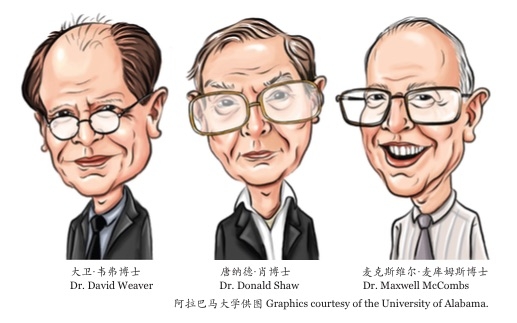
议程设置理论的三位创始人,唐纳德•肖博士、麦克斯维尔•麦库姆斯博士和大卫•韦弗博士2014年11月14日在美国阿拉巴马大学开了一场讲座,与传播信息学院的师生探讨议程设置理论在数字化和碎片化媒体时代的应用与发展。
肖和麦库姆斯在学界以开创议程设置的研究而闻名。两位于1968年总统大选期间在北卡罗莱纳州教堂山进行的民意研究中第一次提出议程设置理论。其《大众媒体议程设置的功能》(The Agenda-Setting Function of Mass Media)一文自1972年发表以来每年都位居被引用最多的论文前十名。2011年,世界舆论研究协会授予肖和麦库姆斯海伦•迪纳曼奖,称赞他们影响了整个学界看待媒体和舆论的思维模式。
韦弗则将“导向需求”的概念引入了议程设置理论,进而将议程设置引向了第二个理论层面,并为议程设置的效果和过程提供了心理学解释。近年来,韦弗的研究兴趣集中在讨论媒体议程的源起,而这方面的研究又将议程设置研究引入了社会新闻学领域。
麦库姆斯于2011年从得克萨斯大学奥斯汀分校新闻学院退休,时为杰西•H•琼斯百年讲座教授。肖退休后现仍回北卡罗莱纳大学教堂山分校大众传播学院执教,是该学院的肯能讲座教授。韦弗也已经从印第安纳大学退休,拥有37年教学和研究经验的韦弗一直是该校前新闻学院的罗伊•豪沃名誉教授。
三位议程设置理论的奠基人在这次讲座中诠释了该理论在不同研究领域的前景和意义。他们的演讲集中探讨了该理论发展的前沿,重点分别置于“第三级议程设置”(麦库姆斯)、“导向需求”(韦弗)和“议程熔合”(肖)。
麦库姆斯:信息网络的力量
麦库姆斯专门介绍了“第三级议程设置”,或称“网络议程设置”的概念。基于几十年的第一级和第二级议程设置效果研究,网络议程设置成为近年研究的新领域。
第一级议程设置研究是由麦库姆斯和肖在1972提出,其基本假设为:在政治竞选中,大众媒体报道的议程将影响选民选择关注哪些政治问题。也就是说,第一级议程设置研究探讨政治议题在媒体报道中的显著性与选民关注度的显著性的相关程度。之后不久,肖和麦库姆斯在1977年对1972年数据的后续研究中提出,不仅仅新闻议题的显著性会影响大众感知,媒体对新闻事件特征描述的显著性也会传递给公众。媒体如何报道事件的特点以及报道所持的立场(支持、反对或中立)都会影响公众对事件的感知。这便是第二级议程设置研究,也称为“属性议程设置”。他们在第一级和第二级基础之上又提出了第三级议程设置假设,肖和麦库姆斯称之为“网络议程设置”。
第一级和第二级议程设置假设媒体所传递的新闻事件和新闻事件属性的显著性是彼此分离的,与之相比,第三级议程设置理论则认为新闻事件和特征的显著性是成批传递给公众的。换句话说,新闻媒体不仅告诉我们“关注那条新闻”(第一级议程设置效果),以及“如何看待它”(第二级议程设置效果),还告诉我们“如何将事件联系起来”。
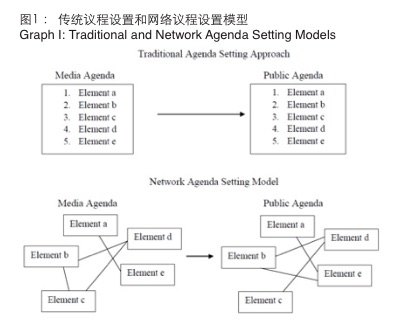
麦库姆斯认为,第三级议程设置的理论基础根源于卡普兰(Kaplan,1973)和安德森(Anderson,1983)的相关性记忆网络模型,即卡普兰所提出的“认知地图”(1973)和安德森提出的“认知结构”(1983)。记忆网络模型认为,人们在理解社会现实的时候,通常会将不同的事件元素在头脑当中联系起来,以形成沃尔特•李普曼所谓的“我们的脑海中的图景”。从大众媒体那里,人们获取信息,体验新闻事件,这样在一天结束时,头脑当中所形成的关于新闻事件的图景是由各种零散信息拼接而成的完形(格式塔,gestalt)。第三级议程设置的核心即为格式塔视角在议程设置理论的延伸。郭蕾(Guo,2013)的图示很好地显示了第一、二级议程设置与第三级议程设置的区别。
到目前为止,第三级议程设置的效果已经得到了实验结果的支持。麦库姆斯提到金(Kim)和麦库姆斯2007年对竞选候选人在报纸和选民心中形象的研究,在对这个起初是第二级议程设置效果的研究进行再次检验的时候,发现网络议程设置的效果统计关联性达到0.67,和原先所发现的第二级议程设置效果——特征关联性0.65的结果十分相近。这个领域最近几年出现了几个高质量的研究成果,比如瓦戈等人(Vargoetal.,2000)对2012总统大选在推特(Twitter)平台上议事日程的研究,以及洪乌、郭蕾和麦库姆斯(Vu,Guo,&McCombs)对2014年度头条新闻与公共议程的网络比较。这两项研究都显示媒体议程和公众议程之间存在着显著的网络关系关联,支持了第三级议程设置假说。
从方法上讲,新闻事件和属性关联所产生的大数据可由电脑协助分析。
新闻事件和关键词可以通过对垂直和水平媒体上的内容进行随机抽样评估来确定。电脑可以辅助频率分析、属性分析和网络分析,从而测量新闻议题和属性之间关联的强度。对议题网络聚合特征的分析将为我们描述个体新闻事件如何单独以及伴随其他新闻议题在媒体议程当中出现。麦库姆斯预计未来大数据分析将为第三级议程设置理论提供更多的实证数据,丰富人们对这个理论假设的理解。
韦弗:“导向需求”(needfororientation)和议程设置的心理学
韦弗的演讲追溯了多年来对“导向需求”(NFO)的研究。个体的“导向需求”被认为是“议程设置产生效果的最重要的一个的条件”(第67页,麦库姆斯,2004年)。麦库姆斯和韦弗在1973年第一次提到个人对使用新闻媒体熟悉外面世界的需要有所不同。导向需求为议程设置效果的个体差异提供了心理学的解释。
导向需求概念提出来的时候被认为有两个纬度,其一是相关性,指观众对所观看的新闻事件是否认为重要;其二是不确定性,指观众对某个事件背景知识的缺乏程度。在最早的夏洛特教堂山的研究当中,导向需求使用分级量表进行测量,首先按照不确定性来定级,再细分相关性,由此分出三个等级的导向需求。夏洛特研究发现导向需求低的选民中呈现的议程设置效果远低于导向需求高的选民。在之后多年的研究中,在世界各地进行的议程设置研究都为这个假设提供了支持——导向需求对议程设置效果具有调节作用(moderatingeffect)。
然而最近许多研究在测量导向需求时,并没有发现其对第二级属性议程设置的效果有显著影响。因此,马特斯(Matthes,2006)提出另一种方式来研究导向需求,即检验导向需求对三个具体的议程设置过程的影响:对新闻事件本身的导向需求,对新闻属性的导向需求,以及对新闻评估的导向需求。在韦弗的演讲中,这三种导向需求被称作客体显著性、实质显著性和评估显著性。马特斯(Matthes,2006)认为在分级测量导向需求的时候,应首先评估相关性。如果个体认为某新闻事件与自己无关,不管他的不确定性水平如何,他的导向需求都很低。只有当相关性高时,不确定性水平才对导向需求产生作用。马特斯(Matthes,2006)以及切尔诺夫、巴伦苏埃拉和麦库姆斯(Chernov,Valenzuela & McCombs,2011)依此设计并检测了新的量表,发现这个量表内部可靠并且可以预测第一级的议程设置效果。但是马特斯(Matthes,2006)的量表只能解释人们寻求信息的过程,而非人们对信息态度的寻求,所以韦弗再次将人们的注意力拉回到由相关性和不确定性组成的二维测量。在Camaj(2014)的最新研究报告中,受众被归为“积极参与需求导向”(高相关性和低不确定性)和“消极参与需求导向”(低相关性和高不确定性)两类,发现积极参与需求导向的受众呈现出更强的议程设置效果。
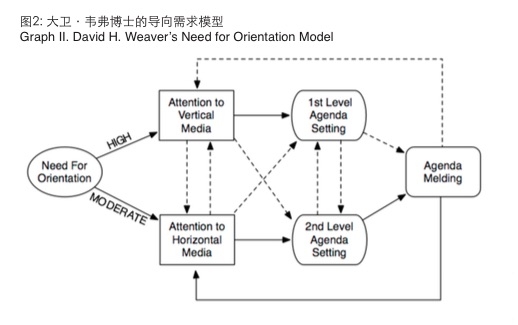
基于现有的导向需求研究,韦弗提出了双路径信息处理和媒体选择模型(图2)。从一个人的导向需求出发,个体可能会选择随意性媒体经验(casual media experience)或者故意性媒体经验(deliberate media exposure),这两种媒体经验将分别导致接触型偏见(accessibility bias)和主观推断型偏见(active inference bias)。议程设置的线索效应更有可能在那些低到中等程度的消极的导向需求的受众当中产生,而那些积极的具有中高等导向需求的受众则更有可能受到议程推理效应的影响。这两组不同导向需求的受众在选择使用主流或者个性媒体时也有不同倾向,所以受到议程设置的影响在级别上有所不同。总之,韦弗提出的模型考虑了包括心理因素、媒体类型、曝光类别等多种因素对议程设置效果的影响,为以后的研究指出了新的方向。
肖:利用媒体观察社会生活,寻找个人社区,创造个体身份
肖的演讲关注如何应用议程设置理论来使媒体服务社会。他认为理解了媒体服务社会的机制,可以为媒体提出服务政府和公民的建议。他精辟地指出“媒体不只是报道社区,媒体即社区。当我们集体离开村庄,来到城市,我们便进入了一个多样和复杂的社会,我们必须依靠许多的媒体平台作为中介来了解复杂的现实。”
议程设置理论是一个有用的工具,因为它结合了媒体过程与影响的两个重要方面:一是新闻记者如何构建公共生活,二是新闻记者在选择构建方式的时候,将受众公民的兴趣考虑在内。因此新闻议程设置也是关于熔合公众兴趣的理论。
要理解人们如何组成他们自己的社区议程,两个简单而重要的概念是垂直(vertical)和水平(horizontal)媒体。垂直媒体指报纸、广播和电视这些传统媒体,它们自上而下地接触受众,就像是从高山上发出呐喊。而水平媒体则是满足个体兴趣,就像杂志和社交网络那样的媒体。它们有着各自独特的受众,将世界上一个个单独的个体链接在一起。当今的世界正在目睹水平媒体设置议程力量的增强,社交网络平台将传统的垂直媒体转化为满足个人所需的水平传媒。与此同时,社区议程则被逐步转化为个体议程。
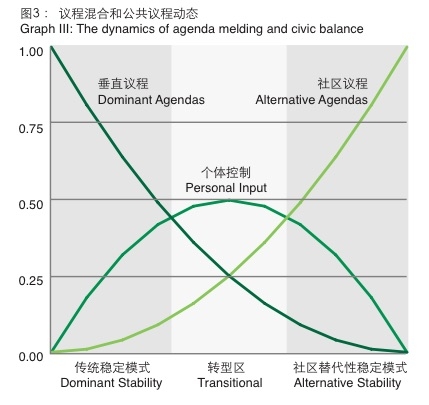
例如,一个2008年对1968年教堂山研究的复制研究发现选民熔合了垂直和水平议程,他们从垂直媒体获取一些信息,从水平媒体中获取另外一些,然后将两部分熔合成为自己关心的议程。在这个过程中,对垂直和水平媒体的选择取决于个体对选举话题的兴趣。如果我们假设一个封闭的、由直接经验和间接来源组成的信息系统,个体的议程可以由下面的公式来预知:

假设垂直媒体议程和选民个体关心的议程之间的关联度是0.8,那么未解释的部分,即来自水平媒体的影响是0.2.将这些数值平方再从整体1之间减去,得到的是选民自己控制的部分(0.32),这部分就是垂直和水平媒体都未能解释的部分。这个公式可以用来通过调查媒体议程,来预测选民关心的话题议程。
基于这个公式,肖用一张线性图描绘了议程熔合的过程。这张图的左侧描绘了一个相对稳定的传统社会模式,垂直媒体和公共议程之间的关联很高。中间部分是传统的整体的社区向分散的社区转化的过程,而当垂直媒体议程和个体议程关联度降到0.5以下,则是此图右侧所描绘的分散的社区替代传统社区的情形。肖说,目前这个假设还有待在世界范围内收集现实数据加以验证。
最后,肖谈到了当代媒体景观和大众媒体受众的演变。随着传统的垂直媒体受众规模逐渐缩小,垂直媒体的议题设置效果可能也在变小。与此同时,个体在选择使用和熔合媒体议程的方式上会呈现代际的差别。这些新特点意味着研究者需要付出更多的努力来理解当今的受众个体独特的议程混合方式,这些努力也将帮助政府和公民来理解一个迎合个体兴趣的水平媒体占支配地位的社会。
三位理论创始人总结了议程设置理论三个重要和特别活跃的研究领域:网络议程设置,导向需求和议程熔合。议程设置理论即将走过50年的历程,如今已经成为一个相当成熟的理论,其每一个分支都在引领着现在和将来的实证研究。麦库姆斯、韦弗和肖期待未来的议程设置研究可以突破以往对公共事务的关注,在延展到其他话题领域的同时加深人们对议程设置理论核心理念的理解。
三位学者对年轻学者的忠告是尽早建立自己的研究方向。他们三人的成就则是活生生的成功典型。他们整个职业生涯持续地为议程设置理论奉献精力,如今退休后仍在努力开创新的研究领域,他们的研究已经成为全世界议程设置理论和实证研究不可或缺的参考文献。
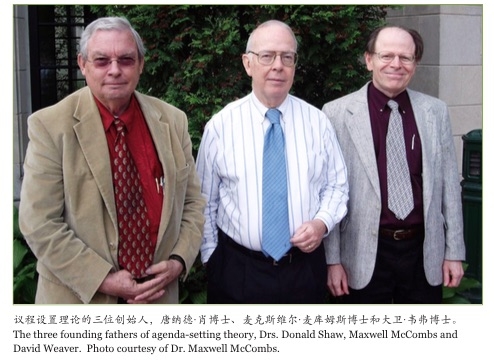
“Three Big Heads” on the future of agenda setting
The three founding fathers of Agenda-Setting theory, Drs. Donald Shaw, Maxwell McCombs and David Weaver, presented a colloquium at Reese Phifer Hall at the University of Alabama on November 14, 2014. Students and faculty of the college of Communication and Information Sciences heard first hand from the “three big heads” about the theoretical implications and the latest applications of agenda-setting theory in today’s digital and fragmented media.
McCombs and Shaw are known to write the first agenda-setting paper. They proposed the theory in their study of the 1968 presidential election in Chapel Hill, North Carolina. Since its publication, the 1972 article “The Agenda-Setting Function of Mass Media” has been one of the top 10 most- cited articles in mass communication research every year. In 2011, the World Association for Public Opinion Research recognized McCombs and Shaw with the Helen Dinerman Award and commended them for influencing “a paradigm shift in how we think about the media and public opinion.”
Weaver is well known for adapting and examining the concept of indi- vidual’s need for orientation (NFO). His work created a second theoretical area for agenda setting and provided a psychological ground for explaining the agenda-setting process. Weaver’s recent endeavor is tracing the origins of media agenda, which links agenda-setting research to another area of mass communication, the sociology of news.
McCombs retired from the faculty of the School of Journalism at the University of Texas at Austin in 2011 as the Jesse H. Jones Centennial Chair in Communication. Shaw, also a professor emeritus, still holds the Kenan Professor in the School of Journalism and Mass Communication at UNC-CH. Weaver is Roy Howard Professor Emeritus after more than 37 years of teaching and research at Indiana University.
The “three big heads” talked about different avenues and domains of agenda-setting research. However, each of their presentations touched the frontiers of the agenda-setting research, respectively, on the third-level agenda setting (McCombs), need for orientation (Weaver) and agenda melding (Shaw).
McCombs: Power of information networks
McCombs has focused specifically on the “third level” of agenda set- ting, or network agenda setting, a new area of agenda-setting research based on decades of studies of first- and second-level agenda-setting effects.
The first-level of agenda setting traces back to McCombs and Shaw’s (1972) original hypothesis that the mass media’s agenda for political campaign would influence the salience of the political issues in the mind of undecided voters. It examines the correlation between the salience of news subjects and perceived key issues among the voters. The second-level agenda setting was proposed soon after in Shaw and McCombs’s (1977) follow-up study of their first agenda-setting study, theorizing that not only the salience of news subjects would transfer to the public’s perception, but also the attributes’ salience of news. That is, the characteristics of the subject as well as the affective components associated with these subjects, such as tones (positive, negative or neutral) of coverage, would affect how the public perceive the news subject. The third-level agenda setting, according to McCombs, has to do with “network agenda setting.”
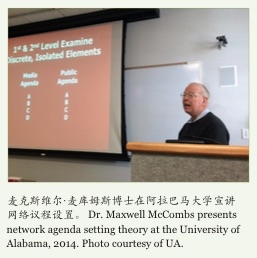
Compared with the first- and second-level agenda-setting research that assume a discrete transfer of the salience of issues or attributes from the news media to the public, the third-level agenda setting theorizes that the subjects and attributes’ salience transfer in bundles between agendas. In other words, the news media not only tell us “what to think about” (first-level agenda-setting effect) and “how to think about it” (second-level agenda-setting effect), but also tell us “what and how to associate.”
McCombs attributed the theoretical ground of third-level agenda setting to Kaplan’s (1973) and Anderson’s (1983) associative network model of memory. Call it the “cognitive maps” (Kaplan, 1973) or “architecture of cognition” (Anderson, 1983), the network model of memory asserts that there is a general tendency for individuals to associate different elements in their minds as an effort to make sense of social realities. To form what Walter Lippmann called “picture in our heads,” individuals turn to media to experience public events and absorb what they are exposed to. At the end of the day, the “pictures in our heads” is a gestalt of elements linked in a variety of patterns. The third-level agenda setting, at its core, is an exten- sion of this gestalt perspective of agenda-setting theory.
There is empirical evidence for third-level agenda-setting effects. One initial effort was the reanalysis of a second-level study of Kim & Mc- Combs’s (2007) examining candidate images among voters and in their local newspaper. A network analysis revealed a correlation of .67, which is very close to the original attribute agenda-setting correlation at .65. Some new studies include Vargo et al.’s (2014) examination on Twitter issue agenda during the 2012 presidential election and Vu, Guo & McCombs’s (2014) network comparison of that year’s top news stories with the public agenda. Both studies suggested significant associations between media agenda and the public agenda, lending support to the third-level agenda-setting hypothesis. The Graph I from Guo (2013) best illustrate the differences between traditional agenda-setting approaches to network agenda- setting research.
Methodologically speaking, computers play a crucial role in big-data content analysis of subject and attribute associations. Issues and keywords can be identified through assessment of random samples of vertical and horizontal media content. Computer assists the analysis of frequency of at- tributes, centrality of attributes and then the analysis of network measures the pair of issues’ strength of association. As a whole, network analysis of centrality describes how often each issue appears over time with other issues on the media agenda. McCombs expects the availability of big data analytics will provide more empirical evidence for and enrich our under- standing of third-level agenda-setting theory in the future.
Weaver: Need for Orientation and the psychology of agenda setting
Weaver’s presentation reported years of research on need for orientation (NFO), or “the most prominent of the contingent conditions for agenda-setting effects” (p.67, McCombs, 2004). In 1973, the concept of NFO was first used in agenda setting by McCombs and Weaver, defined as individuals’ need to familiarize themselves with the outside world via the use news media. However, the concept was not formally introduced until the Charlotte study, when they examined the agenda-setting effects of the news coverage of the 1972 U.S. presidential election. The study suggested NFO as a psychological explanation for individual variance of agenda- setting effects.
When first introduced, NFO was conceptualized as having two dimensions: relevance and uncertainty. Relevance refers to the perceived importance of the issue in audience’s mind, and uncertainty concerns how much people find they lack the knowledge on a particular issue. In the original Charlotte study, NFO was operationalized using a “sequential measurement,” which further subdivided high relevance by uncertainty and pro- duced three levels of NFO. It was found voters with a low NFO showed a much lower correspondence between media agenda and public agenda compared to voters with a high NFO. In the years followed, research of agenda setting around the world provided similar supportive results re- garding the moderating role of NFO on agenda-setting effects.
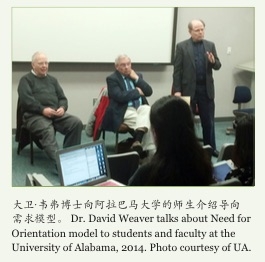
However, many recent studies using this measurement of NFO failed to observe substantial moderation on second-level agenda-setting effects. Thus, Matthes (2006) suggested another way to implement NFO toward three aspects of agenda-setting process: the orientation needs for issues, toward the attributes of those issues, or toward journalistic assessments. In Weaver’s presentation, these aspects were referred to as objective salience, substantive salience and affective salience. Matthes (2006) maintaine the sequential measurement method when identifying NFO. That is, when relevance is low, NFO is low regardless of level of uncertainty. Uncertainty matters only when relevance is high. The new scale was tested by Matthes (2006) and Chernov, Valenzuela and McCombs (2011) as being internally reliable and it predicted the first-level agenda setting at the level of objective salience. However, Matthes’s (2006) scale could only explain the information seeking process, but not the effects of affective attributes. Weaver drew the audience attention back to the two-dimensional NFO scale using a 2X2 typology defined by high and low relevance and uncertainty. Applying this measurement, the most recent study conducted by Camaj (2014) differentiated the “active involvement NFO” (high relevance and low uncertainty) from the “active involvement NFO” (low relevance and high uncertainty), and found the strongest agenda-setting effects among the active involvement NFO people
Based on the existing NFO research, Weaver presented a dual-path in- formation-processing and media-selection model (Graph II). Starting from one’s NFO, casual media exposure or deliberate media exposure is experienced, which results in accessibility bias and active inference bias respectively. Then agenda-cueing effect is more likely to be observed among those who have a low- and moderate-passive NFO while the agenda-reasoning effect occurs among people with moderate- to high-active NFO. The two NFO groups also have different tendency in selecting niche or mainstream media, leading to different intensity of agenda setting at different levels. In conclusion, this comprehensive model to date explains the psychological processes behind agenda setting, including type of exposure, type of medium and type of agenda-setting effect, promising many empirical and theoretical directions for future research.
Shaw: Using media to monitor civic life, find personal community and create private identity
Shaw’s presentation aimed to promote an understanding of how media serve society and how we can advise media to serve government and citizens, based on the agenda-setting research. He succinctly pointed out that, “The media do not merely cover communities, media are communities. When we collectively left our villages for life in cities and urban life, we enter a society so diverse and complex that we must rely on many mediated media to understand it.”
Agenda-setting theory provides a useful approach, according to Shaw, in examining mass media effect because it integrates the important parts of process and effects. On the one hand, journalists frame public life in the media and on the other, journalists take the citizens’ interests into consid- eration when selecting such frames, so the daily news agenda is also about “melding” public’s interests.
In reference to today’s multimedia, the concepts of vertical vs. hori- zontal medium provide easy ways to visualize how people form their own community agendas. Vertical media refer to the traditional newspapers, radio and TV, which reach their audience like shouting from the top of a mountain to the general public. By contrast, horizontal media are created to meet personal interests, such as magazine and social media. They reach a specific public and connect people as individuals around the world. Today the world is witnessing an increased power of horizontal media to set the agenda for the public as social media are on the rise and gradually convert- ing traditional vertical media (newspapers and TV) into horizontal media of personal interests.
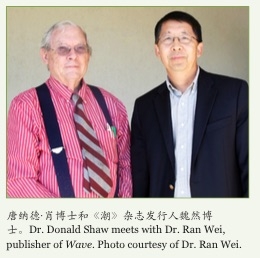
For example, a replication of the 1968 Chapel Hill agenda-setting study in 2008 observed that voters mixed vertical and horizontal agendas. They obtained most of their information from vertical media and some from horizontal media. They then integrated these two news agendas into their own. In this process, the selection of vertical vs. horizontal media hinges upon individuals’ interests in elections. If we assume a closed information system consisting of direct experience and mediated sources, a formula Agenda Community Attraction (ACA) could then be used to predict how individuals form their personalized agenda communities:
Suppose the correlation between vertical media and voters was .80, the unaccounted part attributed to horizontal media would be .20. Square these values and subtract them from 1 gives us the part (.32) controlled by citizens, which is not accounted for by either vertical or horizontal media together. In this way, the formula could be used to predict the voter issues by referencing media agenda.
Based on this formula, Shaw showed a model for the Dynamics of Agenda melding and Civic Balance (Figure 3). The left side of the model suggests a relatively stable social system when correlations of vertical media and public agenda are high. In the middle is a transition period of instability as alternative community agendas gaining power. Moving toward the right shows the trend that alternative agenda community is becoming dominant as long as the correlation falls below .50. Shaw said this hypo- thetical model is yet to be tested with agenda-setting data worldwide.
Finally, Shaw talked about the evolution of media landscape and mass media audience. As the size of traditional, vertical media audience shrinks, the agenda setting effects of vertical media may decline, but those of horizontal media may increase. In addition, different generations differ from each other in their ways of using and melding various media agendas. Shaw believes that we are living at a time of historical paradigm shift. He calls for more efforts in understanding personalized melding of media agendas, and believes such an effort can help governments and citizens understand the challenge of moving toward a world that is more easily transportable by the papyrus paper – the horizontal media messages designed for special interests.
In summary, the “three big heads” presented three important and “particularly active arenas” (p. 782, McCombs, Shaw & Weaver, 2014) of contemporary agenda-setting research-networking agenda setting, NFO and agenda melding. Moving toward its 50 anniversary, agenda-setting theory has become well established with each of these arenas guiding current research now and in the future. McCombs, Shaw and Weaver expect future research to expand the scope beyond the traditional focus on public affairs, but there is also a need to deepen the understanding of core agenda-setting concepts.
One advice they have for young scholars is to have a programmatic research agenda. As vivid exemplars of programmatic research, all three scholars have devoted their entire careers in developing agenda-setting concepts and areas of research, and each one of them continues to look for breakthroughs in this area, even after retirement.
关于作者:周树华,博士,美国阿拉巴马大学传播信息学院教授。主要研究领域有人类对媒体信息的认知,包括信息的表现形式、使用和操纵;认知过程基础,包括感知、注意力和记忆;和认知的个人和情境差异等。周树华在《媒介心理学》、《传播研究》、《广播和电子媒体学刊》、《新闻和大众传播季刊》、《广告学刊》和《大众传播和社会》等传播学刊发表多篇文章。他还合编了《传播学研究方法》和《延续和改变:新闻和大众传播教育视角》两本著作。2007年,周树华被广东电视艺术家协会评为百名优秀电视主持人之一。
About the authors: SHUHU ZHOU, Ph.D., professor of the College of Communication and Information Sciences at the University of Alabama. His primary research area is human cognition of mediated messages, involving the representation, utilization, and manipulation of information; the basic processes of cognition, including perception, attention and memory; and individual and situational differences in cognition. He has published numerous articles in journals including Media Psychology, Communication Research, Journal of Broadcasting & Electronic Media, Journalism & Mass Communication Quarterly, Journal of Advertising and Mass Communication & Society. He has also co-edited two volumes, Research methods in communication and continuity and change: Perspectives on journalism and mass communication education. Zhou was recognized in 2007 by the Guangdong TV Artists’ Association as one of the 100 Best TV Hosts for his professional work as anchor and director of the English News program at Guangdong TV, from 1988 to1993.
张雪莹是美国阿拉巴马大学传播与信息学院的博士研究生。她的研究兴趣集中在新媒体效果和健康研究领域。探究人们的健康行为,例如,人们寻求社会支持的努力,搜索和处理健康相关信息的行为,饮食和锻炼行为如何受到人际传播和大众媒体信息的影响。她的研究项目也包括大众媒体对健康危机事件的报道和媒体公信力的研究。
XUEYING ZHANG is a doctoral student in the College of Communication and Information Sciences at the University of Alabama. Her research interests are new media effect and health communication. Her study concerns how health-related behaviors (e.g., social support seeking, health information seeking and process- ing, dieting and exercising behavior, among other topics) could be changed through interpersonal communication as well as mass media use. She is also engaged in research projects of mass media coverage of health-related crisis and audence’s trust on mass media content.